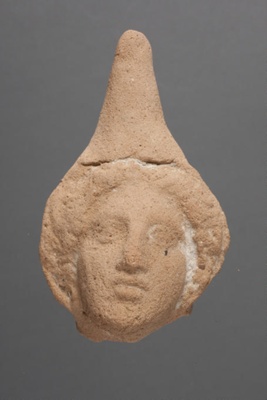< Collection search
< Collection highlights
From:UC Teece Museum of Classical Antiquities
Name/TitleFigurine
About this objectThis portion of a figurine is the demi-god Attis, a Greek and Phrygian deity. Attis was originally a demi-god of Phrygia, which is now in modern-day Turkey. His cult began in around 1250 BC and became popular in Greece in the late 4th Century. His priests are eunuchs, in respect to his origins.
In his origin story, Attis was so beautiful that he attracted Cybele, a mother-goddess sometimes also known as Agdistis. Unfortunately for her, his foster parents had decided that he would marry the daughter of a nearby king. At the wedding ceremony, Cybele appeared, in all her transcendent power, and Attis went mad and castrated himself. In his self-mutilation, death and resurrection he represents the process of crops over the winter, and he is also known in Phrygia as a god of vegetation.
This object, which is highly likely to be from Cyprus, was moulded from orange-buff clay. The figure's youthful face is framed with curly hair, and his eyes are outlined. He is wearing a tall pointed cap. Attis is commonly shown wearing a pointed Phrygian cap in ancient art, making it easier to identify him.
Date MadeDate Unknown
Place MadeCyprus
Place NotesPossibly from Cyprus?
Medium and MaterialsClay: Terracotta
Style and IconographyCypriote
TechniqueMolding (forming)
MeasurementsHeight 101mm
Subject and Association KeywordsArt and mythology
Subject and Association KeywordsFigurative art
Subject and Association KeywordsClothing and dress
Named CollectionThe James Logie Memorial Collection, University of Canterbury, New Zealand
Credit LineDonated by Mrs Broadhead, 1968. From the collection of Professor H.D. Broadhead
Object TypeFigurine
Object number89.68
Copyright LicenceAll rights reserved
